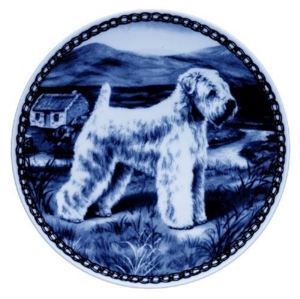Breed standard (approved by Irish Kennel Club)Irish Soft Coated Wheaten Terrier
| General Appearance | A hardy, active, short coupled dog, well built, giving the idea of strength. Not too leggy nor too low to the ground. IMPORTANT PROPORTION : Foreface not longer than skull. |
| Temperament | Spirited and game. Good tempered. Most affectionate and loyal to his owners. Most Intelligent. A trusty, faithful friend, defensive without aggression |
| Head and Skull | In general powerful without being coarse. Hair same colour as on body. Head long, in good proportion to the body. Skull flat and clean between ears, not too wide. Nose : Black and well developed. Jaws : Strong and punishing. Cheeks : Bones not prominent. |
| Eyes | Dark, dark hazel, not too large, not prominent, well placed. |
| Ears | Small to medium, carried in front, level with skull. Dark shading on base of ear allowed, and not uncommon accompanied by a light coloured overlay. " Rose" or " Flying" ears are objectionable. |
| Mouth | Teeth large, regular, scissors or level bite, neither undershot nor overshot. |
| Neck | Moderately long and strong but not throaty. |
| Forequarters | Limbs : Forelegs perfectly straight viewed from any angle. Good bone and muscle. Forequarters : Well developed with powerful muscle. Stifles bent. Hocks : Well let down, turned neither in 'nor out |
| Body | Compact and not too long. Level top line. Chest : Deep, ribs well sprung. Shoulders : Fine, well laid back. Muscular. Loins : Short, powerful. Thights : Strong and muscular. |
| Hindquarters | Hind dewclaws : Must be removed. Feet : Small not spreading. Toenails preferably black but varying colours allowed |
| Tail | Well set not too thick. Carried gaily. Docked at one-third of the total length or cut after the 6th (sixth) joint, assuming that this is in balance and proportion to the dog. |
| Gait/Movement | Coming & going : Straight action fore and aft, going and coming. Elbows tucked in. Side view : Free, light co-ordinated movement. |
| Coat | Hair : Texture soft and silky to feel and not harsh. Young dogs excluded from this. Trimming permitted. Trimmed dogs : Coat cut close to the body and neck, chest and skull, and left especially long over eyes and underjaw. Whiskers encouraged. Profuse feathering on legs. Body coat trimmed to follow the outline of the dog. Tail trimmed close and neatly tapered. Untrimmed dogs : The coat at its longest not to exceed five inches (12,7 cm). Abundant and soft, wavy or loosely curled. (Abundance never interpreted as length). Under no circumstances should the coat be fluffed out like a Poodle or an Old English Sheepdog. Dogs shown in this condition should be heavily penalised as they give a wrong impression of type and breed. Special attention is drawn to puppy coat development. Pups are seldom born with the correct coat of maturity, care must be taken when assessing this point. They go through several changes of colour and texture before developing the adult coat. This usually occurs between 18 months and 2 years. Pups : Are born true to type. They come reddish greyish and sometimes clear wheaten. The masks are generally black. Sometimes there is a black streak down the centre back or black tips to the body coat. These dark markings clear away with growth. No black is allowed at any age with the exception of the muzzle which gradually clears, and the leathers as above (see ears). |
| Colour | Any shade from light wheaten to a golden reddish hue. |
| Size | Height at the withers: Dogs 18 - 19 inches (46 - 48 cm) Bitches somewhat less Weight: Dogs Dogs 35 - 40 lbs (15.75 - 18.0 kg) Bitches somewhat less. |
| Faults | Undershot mouths. Overshot mouths. Nose any colour other than black. Overall mature coat not clear wheaten colour. Nervousness. Viciousness. DISQUALIFYING FAULTS : Yellow eyes. White coats. Brown coats. Dull tick woolly or cottony textured hair. |
| Notes | Male animals should have two apparently normal testicles fully descended into the scrotum. |

